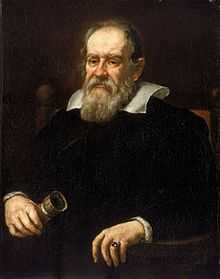And yet it moves

"And yet it moves" or "Albeit It does move" (Italian: Eppur si muove; [epˈpur si ˈmwɔːve]) is a phrase attributed to the Italian mathematician, physicist and philosopher Galileo Galilei (1564–1642) in 1633 after being forced to recant his claims that the Earth moves around the Sun rather than the converse during the Galileo affair.[1]
Some historians believe this episode might have happened instead upon his transfer from house arrest under the watch of Archbishop Ascanio Piccolomini to that of someone less favorable towards his views, near Florence.[2]
The earliest biography of Galileo, written by his disciple Vincenzo Viviani in 1655–1656, does not mention this phrase, and records of his trial do not cite it. It would have been imprudent and potentially lethal for Galileo to have said such a thing before the Inquisition.[3]
In 1911, the line was found on a Spanish painting owned by a Belgian family. This painting was produced within a year or two after Galileo died as it is dated 1643 or 1645 (the last number is partially obscured). The painting is obviously not historically correct, because it depicts Galileo in a dungeon, but nonetheless shows that some variant of the "Eppur si muove" anecdote was in circulation immediately after his death, when many who had known him were still alive to attest to it, and that it had been circulating for over a century before it was published.[4]
The event was first reported in English print in 1757 by Giuseppe Baretti in his book the The Italian Library:[4]:357
The moment he was set at liberty, he looked up to the sky and down to the ground, and, stamping with his foot, in a contemplative mood, said, Eppur si muove, that is, still it moves, meaning the earth.[5]:52
The book was written 124 years after the supposed utterance and became widely published in Querelles Littéraires (1761).[6]
See also
References
- ↑ New Scientist, April 7, 1983. p25.
- ↑ Hawking, Stephen (2003). On the Shoulders of Giants: The Great Works of Physics and Astronomy. Running Press. pp. 396–7. ISBN 9780762416981.
- ↑ Simons, Jay. "Did Galileo Really Say: “And Yet It Moves”?", Retrieved on 1 January 2014.
- ↑ 4.0 4.1 Drake, Stillman (2003). Galileo at Work: His Scientific Biography (Facsim. ed.). Mineola (N.Y.): Dover Publications Inc. ISBN 0486495426.
- ↑ Baretti, Giuseppe (1757). The Italian Library. Containing An Account of the Lives and Works of the Most Valuable Authors of Italy. With a Preface, Exhibiting The Changes of the Tuscan Language, from the barbarous Ages to the present Time. London: Printed for A. Millar, in the Strand. p. 52.
Text preceded by: "This is the celebrated Galileo, who was in the inquistion for six years, and put to the torture, for saying, that the earth moved."
- ↑ A. Rupert Hall, "Galileo nel XVIII secolo," Rivista di filosofia, 15 (Turin, 1979), pp. 375–78, 83.